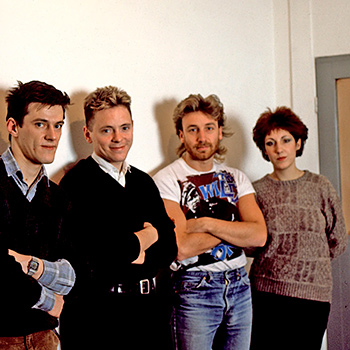
New Order — a cult British band that merged post-punk and electronic music, becoming a symbol of the musical experimentation of the 1980s. The group was formed in 1980 in Manchester from the ashes of the legendary band Joy Division after the death of its frontman Ian Curtis. The members — Bernard Sumner (vocals, guitar, keyboards), Peter Hook (bass), Stephen Morris (drums) and Gillian Gilbert (keyboards) — created a unique sound where the cold aesthetic of post-punk blended with disco and synth-pop rhythms.
Origins from Joy Division
Following the tragic death of Ian Curtis in 1980, the remaining members of Joy Division decided to continue under a new name — New Order. The band retained the emotional depth and atmosphere of their predecessor but introduced electronic synthesizers, drum machines, and dance rhythms, becoming pioneers of dance-rock and electronic new wave.
Bernard Sumner took over as lead vocalist, while the lyrics became less dark and more abstract, reflecting the urban aesthetic of the 1980s.
Breakthrough and Global Fame
Their debut album “Movement” (1981) still carried the shadow of Joy Division’s post-punk roots, but by the release of “Power, Corruption & Lies” (1983), the band had found its own identity. The single “Blue Monday” was a revolution — fusing electronic music, synth-pop and disco, it became the best-selling 12-inch single of all time. The track remains one of the greatest dance anthems ever recorded.
New Order became leaders of the Manchester scene, influencing an entire generation — from Depeche Mode to The Chemical Brothers.
Selected Discography
- Movement (1981)
- Power, Corruption & Lies (1983)
- Low-Life (1985)
- Brotherhood (1986)
- Technique (1989)
- Republic (1993)
- Get Ready (2001)
- Music Complete (2015)
Their hits include “Blue Monday”, “Bizarre Love Triangle”, “True Faith”, “Regret”, “The Perfect Kiss”, and “Ceremony.”
Style and Sound
New Order became a bridge between punk and dance culture. They were among the first to prove that electronic music could be emotional and rock could be danceable. Their style is a fusion of post-punk, synth-pop, new wave, house, and techno.
Key Characteristics:
- Use of analog synthesizers and sequencers;
- Electronic drum machines (Oberheim, Prophet, Emulator);
- Soft, introspective vocals by Bernard Sumner;
- Melodic basslines by Peter Hook — the band’s signature sound;
- A melancholic yet danceable vibe.
Influence and Cultural Significance
New Order are among the most influential bands of the 1980s and 1990s. They were at the forefront of the Manchester Sound and the Haçienda Club Scene — a culture that fused rock and rave. The band shaped the development of Britpop, indie dance, and electronica.
New Order inspired artists such as Pet Shop Boys, Oasis, The Killers, Hot Chip, and LCD Soundsystem.
Break-Up and Reunion
In 1993, after releasing Republic, the band went on hiatus. In the early 2000s, they reunited and released Get Ready, returning to a more guitar-driven sound.
In 2011, Peter Hook left the band, while the remaining members continued performing. Their latest album, Music Complete (2015), received widespread critical acclaim and proved that New Order remain relevant decades later.
Achievements
- Over 40 million records sold worldwide;
- Best-selling 12" single of all time — “Blue Monday”;
- Winners of NME, Q Awards, and Brit Awards;
- Major influence on UK club culture and house music;
- Performed at the iconic Live Aid festival (1985).
Interesting Facts
- “Blue Monday” was originally written as an intro track for concerts and became a hit by accident.
- The band owned the Haçienda club — the epicenter of UK rave culture.
- Their visuals and album covers were designed by Peter Saville — an icon of 1980s graphic design.
- New Order were among the first to use synthesizers alongside live instruments.
- In the 2020s, the band continues to tour, performing at festivals such as Glastonbury, Coachella, and Primavera Sound.
Legacy
New Order are a band that changed the face of modern music. They demonstrated that electronic rhythms could coexist with rock’s emotional depth, and that melancholy could make people dance. Their legacy remains vital, inspiring new generations more than 40 years later.


